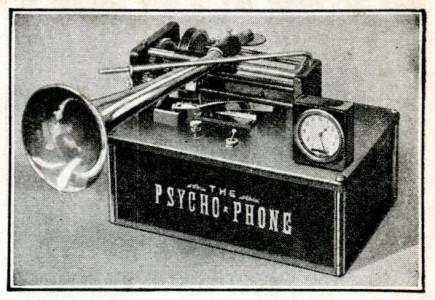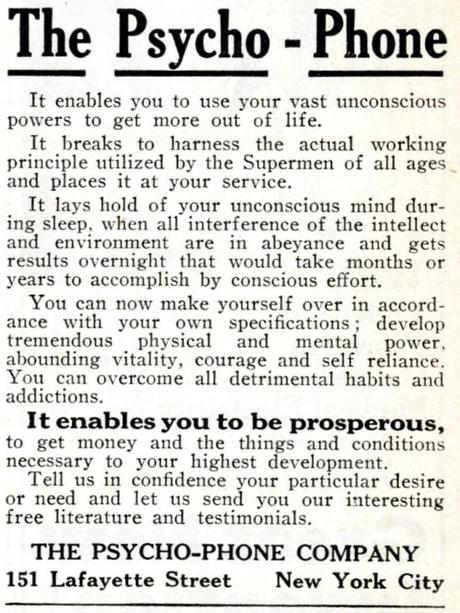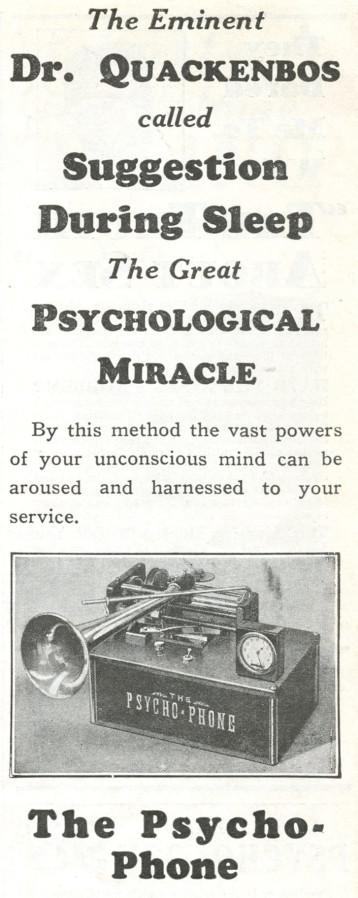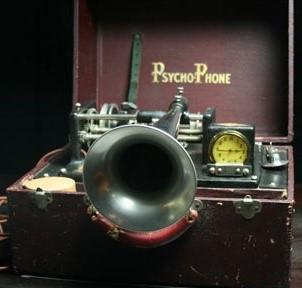– contributed by guest blogger Dr. Ludy T. Benjamin, Jr.
The Cummings Center for the History of Psychology has a large collection of some of the most important apparatus and objects related to psychological science and practice covering the past 150 years. There are brass chronoscopes from the 1800s that measured reaction time in one-thousandths of a second. There are a variety of rat mazes, tachistoscopes, and Skinner boxes. The “shock” machine used by Stanley Milgram in his famous obedience studies is in the Center’s collections as are a Bobo doll from Albert Bandura’s research, guard uniforms from Philip Zimbardo’s Stanford prison study, a surrogate monkey head from Harry Harlow’s studies of love in monkeys, and one of B. F. Skinner’s air cribs. The Center is always looking to add to its collections, including items that were of questionable scientific value. One such item is the Psycho-Phone pictured below.

Similar in principle to audio devices today that play messages during a person’s sleep, for example, alleging sleep learning, the Psycho-Phone was the invention of Alois Benjamin Saliger (1880-1969) who patented his machine in 1932 as an “Automatic Time-Controlled Suggestion Machine.” The device was essentially an Edison-style phonograph with a timer that played the contents from a wax cylinder during the period of sleep. Saliger believed that the messages delivered during sleep would enter a person’s unconscious and have a powerful influence on the individual’s behavior.
The device was first advertised in the June 1927 issue of the popular psychology magazine, “Psychology: Health, Happiness, Success.”

The machine was quite expensive, selling for $235 in 1929. That would be the equivalent of $3,250 in 2017. It came with several wax cylinders, each with messages relating to a different theme; one was labeled “Prosperity”, another “Life Extension,” and a third “Mating.” Eventually Saliger expanded the record library to more than a dozen titles, even one in Spanish. According to a story in The New Yorker in 1933, the message on the Mating recording included the following statements: “I desire a mate. I radiate love. I have a fascinating and attractive personality. My conversation is interesting. My company is delightful. I have a strong sex appeal.” Saliger was convinced of the effectiveness of the Psycho-Phone noting that 50 of his customers reported finding a mate. He did not say how many of the Mating recordings had been sold.
Saliger ran monthly advertisements in the popular psychology magazines of the late 1920s touting the remarkable benefits of his Psycho-Phone. Here is another of his ads.

In looking for expert endorsers of his machine, Saliger might have chosen someone other than Dr. Quackenbos, whose name would not conjure up images of a charlatan.

By 1933, Saliger claimed that he had sold more than 2,500 of the Psycho-Phones. If such a number is even close to being accurate, a number of these devices should still exist today. But despite our best efforts, we have not been able to find one to add to our collections at the Center. If you have one of these or know of the location of a Psycho-Phone we would appreciate your contacting the Center at [email protected]. If you would like to donate one to the Center as a charitable gift, it would be most appreciated.
